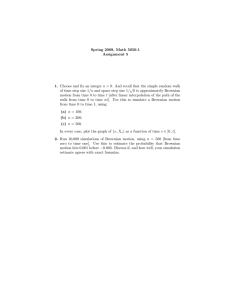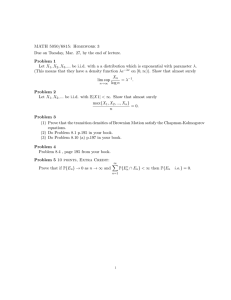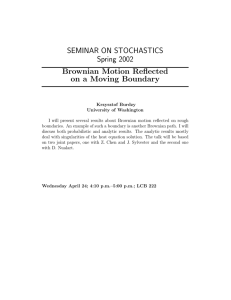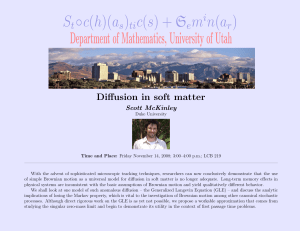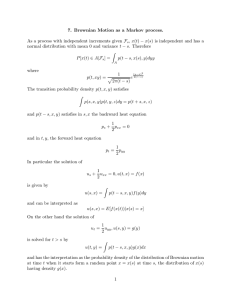INSTITUTE OF TECHNOLOGY MASSACHUSETTS 6.265/15.070J Fall 2013
advertisement
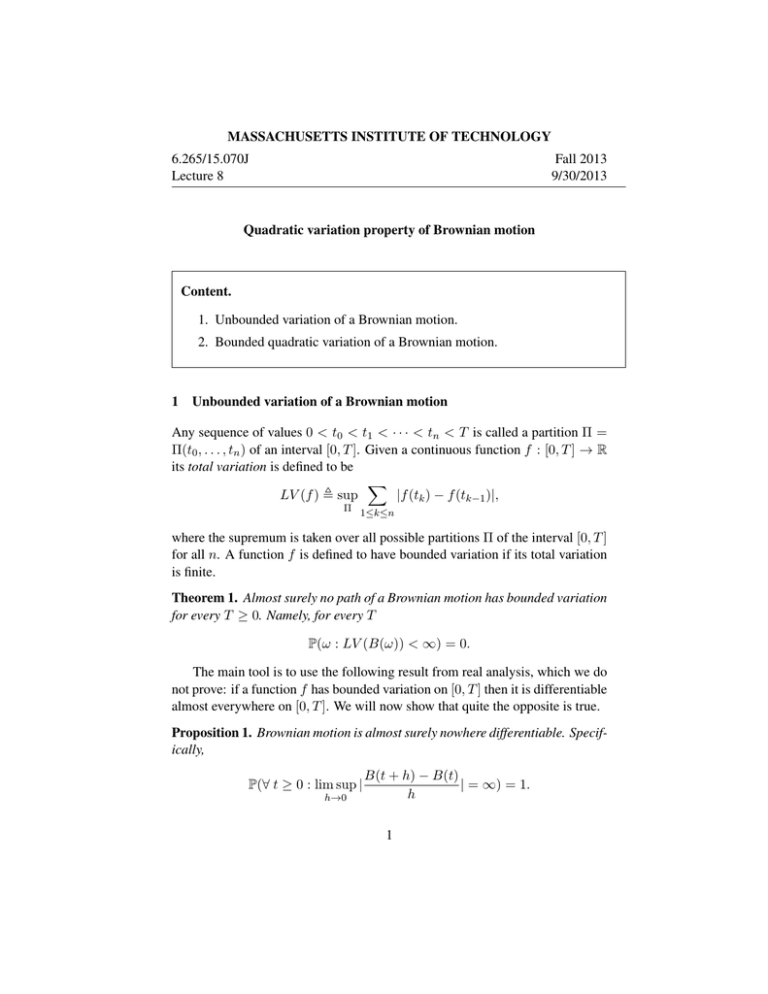
MASSACHUSETTS INSTITUTE OF TECHNOLOGY
6.265/15.070J
Lecture 8
Fall 2013
9/30/2013
Quadratic variation property of Brownian motion
Content.
1. Unbounded variation of a Brownian motion.
2. Bounded quadratic variation of a Brownian motion.
1
Unbounded variation of a Brownian motion
Any sequence of values 0 < t0 < t1 < · · · < tn < T is called a partition Π =
Π(t0 , . . . , tn ) of an interval [0, T ]. Given a continuous function f : [0, T ] → R
its total variation is defined to be
|f (tk ) − f (tk−1 )|,
LV (f ) £ sup
Π 1≤k≤n
where the supremum is taken over all possible partitions Π of the interval [0, T ]
for all n. A function f is defined to have bounded variation if its total variation
is finite.
Theorem 1. Almost surely no path of a Brownian motion has bounded variation
for every T ≥ 0. Namely, for every T
P(ω : LV (B(ω)) < ∞) = 0.
The main tool is to use the following result from real analysis, which we do
not prove: if a function f has bounded variation on [0, T ] then it is differentiable
almost everywhere on [0, T ]. We will now show that quite the opposite is true.
Proposition 1. Brownian motion is almost surely nowhere differentiable. Specif­
ically,
P(∀ t ≥ 0 : lim sup |
h→0
B(t + h) − B(t)
| = ∞) = 1.
h
1
Proof. Fix T > 0, M > 0 and consider A(M, T ) ⊂ C[0, ∞) – the set of all
paths ω ∈ C[0, ∞) such that there exists at least one point t ∈ [0, T ] such that
lim sup |
h→0
B(t + h) − B(t)
| ≤ M.
h
We claim that P(A(M, T )) = 0. This implies P(∪M ≥1 A(M, T )) = 0 which
is what we need. Then we take a union of the sets A(M, T ) with increasing T
and conclude that B is almost surely nowhere differentiable on [0, ∞). If ω ∈
A(M, T ), then there exists t ∈ [0, T ] and n such that |B(s)−B(t)| ≤ 2M |s−t|
for all s ∈ (t − n2 , t + n2 ). Now define An ⊂ C[0, ∞) to be the set of all paths
ω such that for some t ∈ [0, T ]
|B(s) − B(t)| ≤ 2M |s − t|
for all s ∈ (t − n2 , t + n2 ). Then
An ⊂ An+1
(1)
A(M, T ) ⊂ ∪n An .
(2)
and
Find k = max{j :
Yk = max{|B(
j
n
≤ t}. Define
k+2
k+1
k+1
k
k
k−1
) − B(
)|, |B(
) − B( )|, |B( ) − B(
)|}.
n
n
n
n
n
n
In other words, consider the maximum increment of the Brownian motion over
these three short intervals. We claim that Yk ≤ 6M/n for every path ω ∈ An .
To prove the bound required bound on Yk we first consider
|B(
k+2
k+1
k+2
k+1
) − B(
)| ≤ |B(
) − B(t)| + |B(t) − B(
)|
n
n
n
n
2
1
≤ 2M + 2M
n
n
6M
≤
.
n
The other two differences are analyzed similarly.
Now consider event Bn which is the set of all paths ω such that Yk (ω) ≤ 6M/n
for some 0 ≤ k ≤ T n. We showed that An ⊂ Bn . We claim that limn P(Bn ) =
2
0. Combining this with (1), we conclude P(An ) = 0. Combining with (2), this
will imply that P(A(M, T )) = 0 and we will be done.
Now to obtain the required bound on P(Bn ) we note that, since the incre­
ments of a Brownian motion are independent and identically distributed, then
X
P(Bn ) ≤
P(Yk ≤ 6M/n)
0≤k≤T n
3
2
2
1
1
≤ T nP(max{|B( ) − B( )|, |B( ) − B( )|, |B( ) − B(0)|} ≤ 6M/n)
n
n
n
n
n
1
(3)
= T n[P(|B( )| ≤ 6M/n)]3 .
n
Finally, we just analyze this probability. We have
√
1
P(|B( )| ≤ 6M/n) = P(|B(1)| ≤ 6M/ n).
n
Since B(1)√which has the standard normal distribution, its density at any√
point is
at most 1/ 2π, then we have that this probability is at a most (2(6M )/ 2πn).
√
We conclude that the expression in (3) is, ignoring constants, O(n(1/ n)3 ) =
√
O(1/ n) and thus converges to zero as n → ∞. We proved limn P(Bn ) =
0.
2 Bounded quadratic variation of a Brownian motion
Even though Brownian motion is nowhere differentiable and has unbounded
total variation, it turns out that it has bounded quadratic variation. This observa­
tion is the cornerstone of Ito calculus, which we will study later in this course.
We again start with partitions Π = Π(t0 , . . . , tn ) of a fixed interval [0, T ],
but now consider instead
X
Q(Π, B) £
(B(tk ) − B(tk−1 ))2 .
1≤k≤n
where, we make (without loss of generality) t0 = 0 and tn = T . For every
partition Π define
Δ(Π) = max |tk − tk−1 |.
1≤k≤n
Theorem 2. Consider an arbitrary sequence of partitions Πi , i = 1, 2, . . .. Sup­
pose limi→∞ Δ(Πi ) = 0. Then
lim E[(Q(Πi , B) − T )2 ] = 0.
i→∞
3
(4)
Suppose in addition limi→∞ i2 Δ(Πi ) = 0 (that is the resolution Δ(Πi ) con­
verges to zero faster than 1/i2 ). Then almost surely
Q(Πi , B) → T.
(5)
In words, the standard Brownian motion has almost surely finite quadratic vari­
ation which is equal to T .
Proof. We will use the following fact. Let Z be a standard Normal random
variable. Then E[Z 4 ] = 3 (cute, isn’t it?). The proof can be obtained using
Laplace transforms of Normal random variables or integration by parts, and we
skip the details.
Let θi = (B(ti )−B(ti−1 ))2 −(ti −ti−1 ). Then, using the independent Gaussian
increments property of Brownian motion, θi is a sequence of independent zero
mean random variables. We have
X
Q(Πi ) − T =
θi .
1≤i≤n
Now consider the second moment of this difference
X
E(Q(Πi ) − T )2 =
E(B(ti ) − B(ti−1 ))4
1≤i≤n
X
−2
E(B(ti ) − B(ti−1 ))2 (ti − ti−1 ) +
1≤i≤n
X
(ti − ti−1 )2 .
1≤i≤n
Using the E[Z 4 ] = 3 property, this expression becomes
X
X
X
(ti − ti−1 )2 +
(ti − ti−1 )2
3(ti − ti−1 )2 − 2
1≤i≤n
=2
X
1≤i≤n
1≤i≤n
(ti − ti−1 )2
1≤i≤n
≤ 2Δ(Πi )
X
(ti − ti−1 )
1≤i≤n
= 2Δ(Πi )T.
Now if limi Δ(Πi ) = 0, then the bound converges to zero as well. This estab­
lishes the first part of the theorem.
To prove the second part identify a sequence Ei → 0 such that Δ(Πi ) =
Ei /i2 . By assumption, such a sequence exists. By Markov’s inequality, this is
4
bounded by
P((Q(Πi ) − T )2 > 2Ei ) ≤
E(Q(Πi ) − T )2
2Δ(Πi )T
T
≤
= 2
2Ei
2Ei
i
(6)
Since i iT2 < ∞, then the sum of probabilities in (6) is finite. Then apply­
ing the Borel-Cantelli Lemma, the probability that (Q(Πi ) − T )2 > 2Ei for
infinitely many i is zero. Since Ei → 0, this exactly means that almost surely,
limi Q(Πi ) = T .
3 Additional reading materials
• Sections 6.11 and 6.12 of Resnick’s [1] chapter 6 in the book.
References
[1] S. Resnick, Adventures in stochastic processes, Birkhuser Boston, Inc.,
1992.
5
MIT OpenCourseWare
http://ocw.mit.edu
15.070J / 6.265J Advanced Stochastic Processes
Fall 2013
For information about citing these materials or our Terms of Use, visit: http://ocw.mit.edu/terms.

